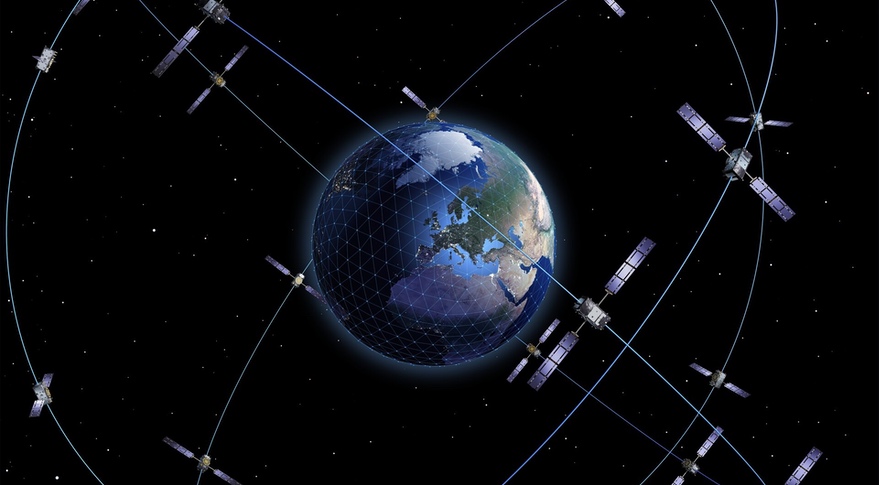Products You May Like
WASHINGTON — The European Space Agency is requesting several hundred million euros at its upcoming ministerial council meeting for new satellite navigation technologies from low Earth orbit to the moon.
In a Nov. 9 briefing, ESA officials said they are proposing about 500 million euros ($518 million) over the next three years for projects to develop advanced technologies beyond its work supporting the European Union-led Galileo system that would both enhance existing services for terrestrial users and expand them to support lunar exploration.
“This fast-growing market has raised the expectations of users in all domains,” said Javier Benedicto, ESA’s director of navigation, requiring improvements in resilience and accuracy. “At the next council at the ministerial level in November, ESA will work towards reinforcing the future capabilities of satellite navigation.”
One initiative, called FutureNAV, will support development of two missions to advance satellite navigation technologies. One, GENESIS, will combine four different measurement techniques on a single satellite to improve the international terrestrial reference frame used for both navigation and Earth science applications.
The other, LEO-PNT, would test a potential future satellite navigation constellation in low Earth orbit through a demonstration involving 6 to 12 smallsats. Operating from LEO, Benedicto said, would allow for stronger signals and greater resistance to jamming, potentially using other frequency bands. “By bringing satellite navigation closer to the Earth, LEO-PNT has the potential to make satellites cheaper and more efficient, and launches more economical.”
The goal of LEO-PNT, ESA officials said at the briefing, is a “fast track” program that would launch the smallsats in 2026 to demonstrate the potential capabilities of such a constellation. That would support future planning for the development of a LEO navigation constellation, including whether it would use standalone satellites or hosted payloads, potentially as part of a broadband constellation.
“We see in the future a growth, an evolution, in the architecture of satellite navigation systems,” he said, with current constellations like Galileo in medium Earth orbit serving as a “backbone” complemented by LEO systems. “The purpose of the in-orbit demonstration, the program we have in mind, is to test this in orbit and demonstrate to ourselves the added value of those new technologies before we take a programmatic decision about the future evolution of this overall architecture.”
A third mission is Moonlight, a joint effort of ESA’s exploration, telecommunications and navigation directorates. Moonlight will develop communications and navigation services on and around the moon to support ESA and partner missions there, starting with a demonstration mission called Lunar Pathfinder being developed by Surrey Satellite Technology Ltd. (SSTL) for launch in 2025.
ESA is wrapping up the first phase of Moonlight, where it awarded study contracts in 2021 to two consortia, one led by SSTL and the other by Telespazio. If funded at the ministerial, ESA is prepared immediately afterwards to issue a request for proposals for a second phase to begin development of Moonlight, with a goal of making a selection in April 2023.
Benedicto said ESA will seek 100 to 150 million euros for Moonlight at the ministerial council meeting, which takes place Nov. 22-23 in Paris. “It is a mission that is very scalable, and we will accommodate the scope of the mission as a function of the budget that is provided by our member states.”
He said ESA is requesting 80 million euros for GENESIS and 100 million for LEO-PNT, as well as 120 million for its Navigation Innovation and Support Programme, or NAVISP, to support work on technologies and services enabled by satellite navigation, such as autonomous driving.
Those efforts are complementary, Benedicto said, to the work funded by the European Commission for the Galileo satellite navigation system. “We have an agreement whereby we have a clear distribution of roles and responsibilities,” he said, with ESA responsible for developing Galileo satellites and the EGNOS augmentation service, which are then operated by the European Union Agency for the Space Programme (EUSPA).
That includes work by ESA building first- and second-generation Galileo satellites, although launches of those satellites are on hold with the loss of the Soyuz vehicle after Russia’s invasion of Ukraine and delays in the introduction of the Ariane 6. He said there is no urgent need to launch additional satellites given the health of the current constellation, although it would be helpful to add to the constellation’s in-orbit spares.
“We are, at the moment, discussing with the European Union the possibility to identify additional launch services, if necessary, for the time frame of the end of 2023, beginning of 2024, in case there would be the need to launch urgently additional satellites to guarantee the continuity of the constellation,” Benedicto said. He later said that included “intense discussions” with launch companies other than Arianespace, although he did not disclose specific providers.
Ove the longer term, he said, ESA would use the Ariane 6, whose first launch is currently scheduled for no earlier than the fourth quarter of 2023. “Ariane 6 remains our workhorse. It is our baseline for deployment of the Galileo constellation in the future.”
